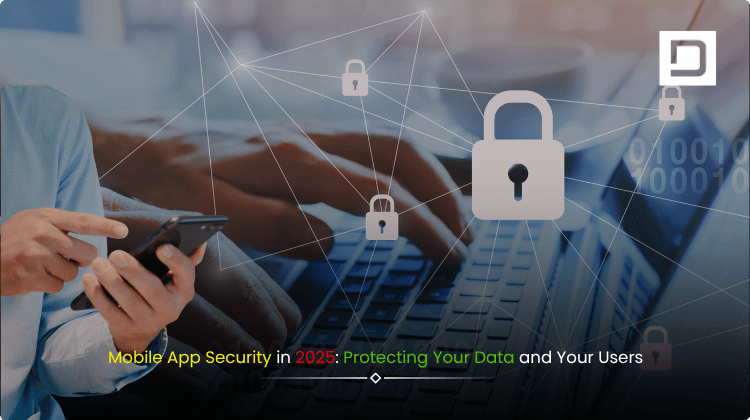Mobile App Security in 2025: Protecting Your Data and Your Users
In 2025, mobile app security is no longer a technical afterthought—it is a business imperative. As our digital lives become ever more mobile-centric, the apps we use every day have become prime targets for cybercriminals and data thieves. With billions of users relying on mobile apps for everything from banking to healthcare and social networking, ensuring airtight security is crucial for both protecting user data and upholding brand trust.
The keyword Mobile App Security in 2025 encapsulates more than just technology; it reflects a rapidly evolving threat landscape, new compliance mandates, and heightened user expectations for privacy. Companies can no longer afford to cut corners on security. A single breach can lead to catastrophic financial, reputational, and legal consequences.
As a leading software development company, Depex Technologies understands these high stakes. In this comprehensive guide, we explore the latest trends, best practices, and must-have features for mobile app security in 2025—equipping business leaders, CTOs, app product owners, and development teams to make informed decisions and safeguard their users in an age of relentless cyber threats.
Understanding the Modern Threat Landscape
The threat landscape for mobile applications in 2025 is more sophisticated and dynamic than ever before. With the proliferation of AI-driven attacks, phishing schemes, malware, and the constant evolution of hacking tools, attackers can exploit even minor vulnerabilities.
The Growing Attack Surface
Every new feature, integration, and user permission in a mobile app adds to its attack surface. Today’s apps often connect to cloud services, third-party APIs, IoT devices, and enterprise backends, each presenting unique security challenges. As the number of connected devices soars past 30 billion globally, attackers have more entry points than ever.
Common Attack Vectors in 2025
- Malicious Apps & Clones: Cybercriminals publish counterfeit versions of legitimate apps to steal user credentials and sensitive data.
- Man-in-the-Middle (MitM) Attacks: Intercepting and altering communication between users and app servers, often on unsecured Wi-Fi networks.
- Reverse Engineering: Hackers decompile apps to expose proprietary algorithms, cryptographic keys, or business logic.
- Code Injection & Runtime Manipulation: Injecting malicious code at runtime to bypass authentication or escalate privileges.
- Phishing & Social Engineering: Targeting users through deceptive messages or fake app interfaces.
The sophistication of these attacks makes proactive, multi-layered security essential.
Regulatory Landscape: Compliance Drives Security Forward
By 2025, data privacy and security regulations have grown both more stringent and more global. Organizations developing mobile apps must navigate not only established standards like GDPR (General Data Protection Regulation), CCPA (California Consumer Privacy Act), and HIPAA (Health Insurance Portability and Accountability Act), but also evolving frameworks such as India’s Digital Personal Data Protection Act and cross-border data transfer rules.
Key Compliance Considerations
- Data Localization: Laws in India, China, and the EU increasingly require sensitive data to be stored within national borders.
- User Consent & Transparency: Explicit user consent is required for data collection and processing, including clear disclosures in privacy policies.
- Data Minimization: Apps must collect only the data absolutely necessary for functionality.
- Breach Notification: Strict timelines mandate rapid disclosure to users and authorities after any breach.
Non-compliance is costly. In 2024 alone, global fines for privacy breaches topped $12 billion. In 2025, forward-thinking organizations are integrating compliance requirements into every phase of app development.
Core Principles of Mobile App Security in 2025
App security is not a one-time checkbox but a holistic approach woven throughout the development lifecycle. Here are the essential principles guiding robust mobile app security in 2025:
1. Security by Design
Security must be an integral part of the app design and architecture from day one. This includes threat modeling, identifying high-risk data flows, and defining security controls before any code is written.
2. Zero Trust Architecture
Adopting a Zero Trust approach means never trusting any device, user, or network by default—even internal ones. All requests must be continuously authenticated, authorized, and encrypted.
3. Privacy-First Mindset
Prioritizing user privacy builds trust and ensures regulatory compliance. Only collect and retain data that is strictly necessary, and be transparent about how it is used.
4. Continuous Security Testing
Vulnerabilities can arise at any time. Automated and manual security testing—including static/dynamic analysis, penetration testing, and code reviews—must be a constant throughout the app lifecycle.
5. Rapid Incident Response
When a breach or vulnerability is detected, organizations need clear plans and tools for rapid detection, containment, and remediation, minimizing damage and user impact.
Essential Mobile App Security Features and Technologies in 2025
Let’s delve into the must-have features and technologies for Mobile App Security in 2025, explaining how they defend both data and users:
End-to-End Encryption
All sensitive data—whether stored on the device, in transit between devices and servers, or resting in the cloud—must be encrypted with strong cryptographic algorithms. In 2025, quantum-resistant encryption standards are gaining traction, helping future-proof apps against the next generation of attacks.

Multi-Factor Authentication (MFA) and Biometrics
Password-based authentication is no longer enough. Leading apps require users to authenticate via multiple factors—combining something they know (password/PIN), something they have (a device or OTP), and something they are (biometric verification like fingerprint or face ID). Biometric authentication is now more advanced and resistant to spoofing, with built-in liveness detection.
Secure APIs and Backend Services
With most apps relying on APIs, API security is a cornerstone of mobile app protection. API gateways, strict authentication tokens (OAuth 2.0/OpenID Connect), and request validation stop attackers from exploiting backend systems.
Runtime Application Self-Protection (RASP)
RASP tools are embedded within the app, providing real-time monitoring and automatic defense against code injection, tampering, and abnormal behavior. This means that even if a vulnerability slips through, RASP can neutralize the threat in real-time.
Advanced App Shielding and Obfuscation
To protect proprietary code and logic, app binaries are obfuscated, making reverse engineering difficult. App shielding also injects anti-tamper checks, root/jailbreak detection, and runtime integrity verification.
Secure Data Storage
Sensitive information like credentials, tokens, and user data should never be stored in plain text. On-device storage uses encrypted containers and hardware-backed security (such as Trusted Execution Environment, Secure Enclave, or Android Keystore).
Real-Time Threat Intelligence
Modern security platforms integrate with global threat intelligence feeds, enabling real-time updates about emerging threats, malicious IPs, and compromised credentials. Apps can respond dynamically to evolving risks.
AI-Powered Anomaly Detection
With machine learning, apps can continuously monitor user and system behavior, flagging suspicious activities such as credential stuffing, unusual access patterns, or fraudulent transactions before they escalate.
The Role of AI in Mobile App Security
In 2025, AI isn’t just a buzzword—it’s a core component of mobile app defense. Here’s how artificial intelligence is transforming app security:
Automated Threat Detection
AI algorithms analyze vast quantities of app data, identifying threats and anomalies that human analysts might miss. This includes detecting zero-day attacks, previously unknown malware, and social engineering schemes.
Dynamic Risk Assessment
AI models assess the real-time risk of user actions, adapting security measures accordingly. For example, if a user logs in from a new device or location, the app can require additional authentication or restrict sensitive transactions.
Intelligent Fraud Prevention
From banking to e-commerce apps, AI engines are continuously monitoring for fraud indicators—such as rapid credential guessing, impossible travel patterns, or payment manipulation—and intervening instantly.
Continuous Security Testing
AI-driven tools automate penetration testing, vulnerability scanning, and code reviews, finding weaknesses early and reducing manual effort.
Enhanced Privacy Controls
Natural language processing (NLP) helps apps analyze privacy policies, user permissions, and data flows to flag privacy risks and improve transparency.
Secure App Development Lifecycle: A Step-by-Step Approach
Delivering a secure mobile app in 2025 requires a secure software development lifecycle (SDLC) that integrates security at every stage:
1. Requirements and Design
Security requirements are defined alongside functional requirements. Threat modeling is conducted to identify potential risks and establish the necessary controls.
2. Secure Coding Practices
Developers are trained in secure coding standards (such as OWASP Mobile Security Project guidelines), using tools that automatically check for insecure code patterns, hardcoded secrets, and unsafe libraries.
3. Static and Dynamic Analysis
Before release, code undergoes automated static analysis (scanning source code for vulnerabilities) and dynamic analysis (testing the running app for real-world exploits).
4. Penetration Testing
Certified ethical hackers simulate real-world attacks against the app and backend services, identifying any exploitable weaknesses before launch.
5. Continuous Integration and Delivery (CI/CD)
Security checks are embedded within the CI/CD pipeline. Any failed security test automatically blocks the deployment, ensuring only safe builds reach production.
6. Post-Release Monitoring
Once the app is live, continuous monitoring tools track for abnormal behavior, suspicious logins, and unauthorized access attempts. Real-time alerts enable rapid incident response.

Key Security Challenges for Mobile Apps in 2025
Despite the advanced tools and frameworks, mobile app security faces several persistent and emerging challenges:
The Rise of Supply Chain Attacks
Hackers increasingly target the app development supply chain—compromising third-party libraries, SDKs, or APIs used by apps. By injecting malicious code upstream, attackers can compromise thousands of apps simultaneously.
Balancing Security and User Experience
Users demand fast, seamless experiences, while security often introduces friction (such as MFA or biometric checks). The challenge is building robust security without degrading user experience.
Device and OS Fragmentation
With hundreds of device models, OS versions, and custom ROMs in circulation, ensuring consistent security across all platforms is tough. Some devices lack hardware-backed security, increasing risk.
Evolving Attack Techniques
Attackers leverage AI, social engineering, and sophisticated malware to find new ways in. Security teams must continually update their defenses to stay ahead.
The Cost of Security Breaches
The consequences of a mobile app data breach in 2025 can be severe:
- Financial Losses: From direct theft and fraud to regulatory fines and compensation payouts, breaches can cost millions.
- Reputational Damage: Losing user trust can devastate an app’s user base and impact brand value for years.
- Legal Action: Organizations face lawsuits from users, partners, and regulators after breaches, especially if found negligent.
- Business Disruption: Remediating a breach often involves taking systems offline, halting development, or delaying product launches.
Investing in robust mobile app security is not just a technical necessity—it’s a strategic business decision.
Case Studies: Real-World Security Failures and Lessons Learned
The Banking App Breach
In late 2024, a major banking app in Europe suffered a data breach that exposed millions of user records. The cause? A third-party SDK included in the app’s update process was compromised. Attackers gained persistent access for months before discovery. The aftermath included regulatory investigations, fines exceeding $50 million, and a wave of customer churn. The incident underscored the need for rigorous supply chain security and continuous code auditing.
Social Media App Phishing Attack
A popular social media app saw a wave of user account takeovers in early 2025. Attackers exploited weak password policies and lack of MFA, then sent phishing messages to contacts. The attack spread rapidly, damaging user trust and requiring a costly post-breach cleanup. This case highlights the importance of strong authentication mechanisms and proactive user education.
Healthcare App Data Exposure
A healthcare provider’s mobile app inadvertently exposed sensitive medical data due to improper API access controls. Regulatory penalties and class-action lawsuits followed. This event stressed the need for robust API security and strict data access policies, especially for regulated industries.
Best Practices for Mobile App Security in 2025
Let’s summarize the actionable best practices that every mobile app should adopt:
Encrypt Everything, Always
Data encryption should be comprehensive—covering data at rest, in transit, and in use. Use industry-leading, quantum-resistant algorithms.
Embrace Multi-Factor Authentication
Require MFA for sensitive actions and account access, leveraging biometric and device-based authentication.
Secure Your APIs
Use strict authentication, request validation, and rate limiting for all API endpoints. Regularly test APIs for vulnerabilities.
Prioritize Privacy by Design
Collect the minimum necessary user data. Use consent management, transparent privacy policies, and allow users to control their data.
Automate Security Testing
Integrate automated security scanning and AI-driven code analysis into your development workflow. Supplement with regular manual penetration testing.
Monitor and Respond in Real Time
Deploy real-time monitoring tools, leverage threat intelligence, and maintain a well-tested incident response plan.
Educate Your Users
Teach users about phishing risks, safe password practices, and the importance of app updates.
Vet Your Third-Party Dependencies
Continuously audit third-party libraries and SDKs for vulnerabilities. Only use trusted, regularly updated components.
Why Choose Depex Technologies for Secure Mobile App Development?
Depex Technologies is committed to delivering not only innovative and high-performing mobile apps, but also apps that set industry standards for security and privacy. Here’s how we stand out:
Security-First Culture
From initial brainstorming to post-launch support, security is at the heart of our development process. Our teams are trained in the latest secure coding practices, compliance requirements, and AI-driven security solutions.
Full-Lifecycle Security Integration
We embed security at every stage—requirement gathering, design, development, testing, deployment, and ongoing maintenance—ensuring no gaps or oversights.
Advanced Technology Stack
Our solutions incorporate the latest encryption standards, biometric authentication, API security, RASP, AI-powered monitoring, and compliance automation.
Regulatory Compliance Expertise
We have deep experience navigating GDPR, HIPAA, CCPA, and other global privacy laws. Our compliance experts keep your app ahead of regulatory requirements.
Dedicated Support and Monitoring
Our partnership doesn’t end at launch. We provide continuous monitoring, incident response, and regular security updates to keep your app and your users safe.
Transparent Communication
We work closely with clients to educate, advise, and deliver secure, future-proof mobile applications tailored to your business goals.
Conclusion: Secure Your Future with Depex Technologies
In 2025, Mobile App Security is the cornerstone of user trust, regulatory compliance, and business success. With ever-evolving threats, sophisticated attack methods, and stricter data privacy laws, companies must make security a top priority at every step.

Don’t leave your app—and your users—exposed. Partner with Depex Technologies to build mobile apps that not only delight users, but also set the gold standard for security and privacy in 2025 and beyond. Our expert team is ready to help you design, develop, and maintain secure mobile solutions tailored to your needs.
Ready to safeguard your users and your reputation?
Contact Depex Technologies today to start building secure, reliable, and future-ready mobile apps.






